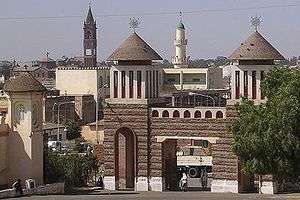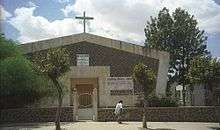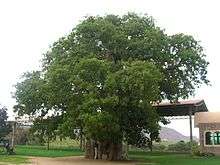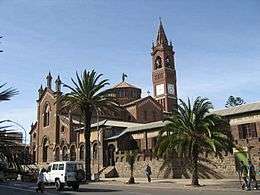Religion in Eritrea
| U.S Department of State (2011)[1] | Pew Research (2009)[2] |
|---|---|

Religion in Eritrea mainly consists of Abrahamic faiths. Since May 2002, the Eritrean government has officially recognized the Eritrean Orthodox Tewahedo Church, the Eritrean Catholic Church, the Evangelical Lutheran church, and Islam. All other faiths and denominations are in principle required to undergo a registration process; in practice they are not allowed to register.[3] Among other things, the government's registration system requires religious groups to submit personal information on their membership to be allowed to worship.[3]
There are two major religions in Eritrea, Christianity and Islam. However, the number of adherents is subject to debate. In 2010, the United States Department of State (USDoS) estimated that 50% of the population was Muslim and around 48% was Christian.[4] According to the Pew Research Center, around 62.9% of Eritrea's population in 2010 adhered to Christianity, and 36.2% followed Islam. The remaining 0.9% of residents practiced other religions, including traditional faiths and animism.[5]
The Kingdom of Aksum, covering much of modern-day Eritrea and northern Ethiopia, arose somewhere around the first or second centuries.[6][7] The Aksumites erected a number of large stelae, which served a religious purpose in pre-Christian times.[8] Over 200 years after the kingdom's formation, it adopted Christianity under King Ezana.[9] Eritrea was also one of the first Islamic settlements in Africa, as a group of Muslims facing persecution in Mecca migrated to Abyssinia (now Ethiopia), through modern day Eritrea.
Faiths and denominations
The denominations of the religions in Eritrea also differ from source to source.
For Christianity the Pew Research Center indictes that, of the Eritrean population, 57.7% are Orthodox Christians, 4.6% are Roman Catholic, 0.7% are Protestants and less than 0.5% are other Christians.[10] Eritrea: Religious Distribution gives 58% Orthodox, 5% Roman Catholic, less than 1% Protestant.[11] The Department of State says that 30% are Orthodox, 13% Roman Catholic and others, which includes "Protestants, Seventh-day Adventists, Jehovah's Witnesses, Buddhist, Hindus, and Baha'is", at less than 5%.[4][12]
The United States Department of State indicates that 50% of the population are Sunni Muslims but gives no figures for Shias,[4] while a 2009 Pew Research Center report says that less than 1% are Shia.[13]
Around 0.9% of local residents follow traditional religions or other faiths. Atheism is low, while participation in religion is high among all ethnicities.[12]
All religious groups other than the four officially recognised faiths—the Eritrean Orthodox Church, the Evangelical Lutheran Church, Islam, and the Roman Catholic Church—must be registered with the government of Eritrea. The government has refused to register any religious group despite some of them meeting the requirements.[12]

| Region[11] | Population | Christians | Muslims | Other |
|---|---|---|---|---|
| Maekel Region, ዞባ ማእከል | 1,053,254 | 94% | 5% | 1% |
| Debub Region, ዞባ ደቡብ | 1,476,765 | 89% | 11% | <1% |
| Gash-Barka Region, ዞባ ጋሽ ባርካ | 1,103,742 | 36% | 63% | 1% |
| Anseba Region, ዞባ ዓንሰባ | 893,587 | 39% | 61% | <1% |
| Northern Red Sea Region, Semienawi Keyih Bahri ዞባ ሰሜናዊ ቀይሕ ባሕሪ |
897,454 | 12% | 87% | <1% |
| Southern Red Sea Region, Debubawi Keyih Bahri ዞባ ደቡባዊ ቀይሕ ባሕሪ |
398,073 | 37% | 62% | <1% |
Abrahamic religions
Judaism is thought to have existed as an important religion in Eritrea and Ethiopia before Christianity became the official religion of the Kingdom of Aksum (today's Ethiopia and Eritrea) in the early 4th century AD. Islam spread to Ethiopia and Eritrea around 615 AD with the arrival of Uthman ibn Affan, one of the Sahabah (companions) of the Islamic prophet Muhammad. Uthman had been driven out of Saudi Arabia and found shelter at Axum in the Tigray Region of Ethiopia under the protection of the Axumite king, Aṣḥama ibn Abjar.

Another great power came in the person of the Imam of Harar in Ethiopia, Ahmad ibn Ibrahim al-Ghazi, also known as Ahmad Gurey or Gragn. Al-Ghazi led Muslim forces consisting of Somali, Harari, Oromo, Afar, Saho, Argobba, Hadiya, Silte and Gurage soldiers from present-day Ethiopia, Eritrea, Djibouti and Somalia. The Ethiopian Christians are the Tigray-Tigrinya and the Amhara, while the Eritrean Christians are the Tigray-Tigrinya. In 1530 he began to attack the plateau. Within four years he laid waste to the majority of the Christian highlands, including the Tigray Region of Ethiopia and Eritrea. He converted hundreds of thousands of Christians to Islam by force. Only by surrender and conversion could people save their lives. Only the intervention of the Portuguese transformed the flow of events. They landed at Massawa in 1541 and helped the Eritreans and Ethiopians to drive the Imams forces from the plateau. The Muslim forces dispersed, retreated and disappeared.
Catholicism was first brought to Eritrea by the Jesuits in 1600. In 1632, this order was expelled from Eritrea for wanting to convert the country (an Orthodox country) to Catholicism. In the 19th century the Italians began to bring Eritrea under their sphere of influence and introduced Roman Catholicism again. The Protestant presence in Eritrea is small. Missionaries appeared in the 19th century and established the Lutheran and Evangelical churches. These organizations have been allowed to continue to practice. New groups however, have been discouraged from establishing a base in Eritrea.
Christianity

Christianity is the religion of about 50% to 63% of the population of Eritrea.[4][10][11] While elsewhere on the continent, Christianity in Africa was primarily introduced by European missionaries, this was not the case with the Tigray-Tigrinya people of Eritrea and Tigray Reigon in neighbouring Ethiopia (or with the Amhara people of Ethiopia). The ancient empire of the Kingdom of Aksum centered in north Tigray and the central highlands of Eritrea had intimate connections with the Mediterranean world in which Christianity grew. Christianity arrived in the Eritrean and Tigrayan area in the 4th century, growing dynamically in the pre-existing Jewish/Animistic mixed environment. The Tigrayan-Tigrinyas thus converted to Christianity centuries before most of Europe, thereby establishing one of the oldest state churches in the world. The Eritrean Orthodox have their origins in the 4th century Coptic mission of Syrian Frumentius in East Africa, when the first Archbishop was elected for the Aksumite Empire, under Ezana of Axum (r. 320-360). Among ecclesiastical buildings, most notable date from the 6th to the 14th centuries; for example Libanos, Bizen and Sina.
Location and ethnicity
The majority of Christians are found in the Eritrean Highlands found in southern, central and parts of northern Eritrea. A majority of the Tigrinya who constitute almost 60% of the population are Christian. The majority of the Kunama are Catholic, with a small minority of Muslims and some who practice traditional indigenous religions. Approximately 40% of the Bilen are Christian, the majority being Catholic.[12]
Eritrean Orthodox Tewahedo Church
According to some sources, Orthodox Christians make up 57.7% of the population. A majority of the Christian population of Eritrea belongs to the Eritrean Orthodox Tewahedo Church, which used to belong to the formerly Coptic Ethiopian Orthodox Tewahedo Church. The Eritrean Church was recognized by the Coptic Orthodox Church of Alexandria following independence in 1993, and in 1994 the two neighbouring churches affirmed their respective status.[14] In April 1998 the former Archbishop Abune Phillipos of Asmara was elevated to the rank of Patriarch. He died in 2004 and was succeeded by Abune Yacob. The reign of Abune Yacob as Patriarch of Eritrea was very brief as he died not long after his enthronement, and he was succeeded by Abune Antonios as 3rd Patriarch of Eritrea. Abune Antonios was elected on 5 March 2004, and enthroned as the third Patriarch of the Orthodox Tewahedo Church of Eritrea on 24 April 2004. Pope Shenouda III presided at the ceremony in Asmara, together with the Holy Synod of the Eritrean Orthodox Church and a Coptic Orthodox Church delegation. He was later formally deposed by the government. However many believe that Abune Antonios was wrongly deposed and still consider him Patriarch. Many Eritrean Orthodox followers disagree with the Eritrean government making decisions in religious matters.
Catholicism
Catholics make up 4.6% of the Eritrean population.[4][10][11] The Eritrean Catholic Church and Roman Catholic Church has dioceses of Asmara, Keren and Barentu. Catholics in Eritrea, follow both the Latin rite and the Eritrean rite. There are three territorial jurisdictions in the country known as eparchies. During the era of Italian Eritrea, Roman Catholicism was introduced into the country. Today the church is a distinctly Eritrean church, although masses continue to be held in Italian and Latin along with local languages among Tigrinya and it also caters to the very small Italian and Italo-Eritrean community mainly in Asmara. The nation previously had many adherents of the original Roman Catholic Church, most of whom were Italian Eritreans. When Eritrea was an Italian colony, all the Italians (colonists and military troops) professed the Latin rite: in 1940 they constituted 11% of the total population. The Cathedral of Asmara was their main religious center. So, in the early 1940s Catholicism was the religion of nearly 28% of people in the colony of Italian Eritrea.[15] Now many of the descendants of these Italian Eritreans have converted to the Eritrean Orthodox Tewahedo Church.
Protestantism
Protestants, sometimes know by the slang name P'ent'ay, in Eritrea make up between less than 1% to 5% of the Christians.[4][10][11] A minor church is the Kale Hiywot Church of Eritrea. Protestant denominations include Christian Brethren, Evangelical Church Mekane Yesus, Evangelical Lutheran Church of Eritrea. In 1926, Swedish missionaries founded the Evangelical/Lutheran Church of Eritrea. However there was tension between the Catholic Church as the Roman Catholic Italians resisted and discouraged the spread of Protestantism in their colony and even lay prohibitions and numerous constraints on the activities of the Swedish missionaries. The Lutheran Church of Eritrea and its Swedish and Eritrean missionaries were the ones who translated the Bible from Ge'ez language only understood by higher clergymen, into the Tigrinya language and other local languages and their main goal was to reach and "enlighten" as many people as possible in the world through education.
Islam
.jpg)
Islam accounts for approximately 36% to 50% of the population.[4][11][16] More than 99% of Eritrean Muslims practice Sunni Islam.[13]
Islam first arrived to the region when immigrants from Mecca, persecuted by the ruling Quraysh tribe were accepted into Abyssinia by the ruler of Ethiopia whom Arabic tradition has named Aṣḥama ibn Abjar, and he settled them in Negash, located in the Tigray Region of Ethiopia. Muhammad himself instructed his followers who came to Ethiopia, to respect and protect Ethiopia as well as live in peace with Ethiopian Christians. Islam later spread in Eritrea under the Ottoman Empire when ethnic groups like the Tigre people in mainland Eritrea began converting to Islam. In the late 19th century, during the reign of Emperor Yohannes IV, who was a devoutly Christian Tigrayan, Muslim Tigrayans were forcibly expelled from their homes and found refuge in the nearby northern areas in what is now Eritrea, out of reach of royal Ethiopian authority.
Location and ethnicity
The majority of Muslims in Eritrea inhabit the eastern, coastal lowlands as well as the western lowlands near the border with Sudan. Most belong to various Afro-Asiatic communities, especially the Tigre, Saho, Afar, Rashaida, Beja and Bilen ethnic groups.[12] About 5% of the Tigrinya are also Muslims; they are known as the Jeberti, though they claim a different ethnic background from the Biher-Tigrinya; the Rashaida are an Arab tribe who migrated from Yemen.
Additionally, many of the Nilo-Saharan-speaking Nara ethnic minorities also adhere to Islam, as do some of the Kunama Nilotes.
Judaism
It is believed that before Christianity became the official religion of Abyssinia (ancient Eritrea and northern Ethiopia) in the 4th century, Judaism had a heavy presence in Eritrea. Those who refused to embrace the new religion were compelled to seek refuge in the mountains of southern Ethiopia. This explains the concentration of Jews known as Beta Israel or Falasha in Gondar, Ethiopia and southern Tigray. However, there was not much oppression against ethnic Jews.
The present Eritrean Jewish community is believed to be started by Yemenite Jews from Yemen attracted by new commercial opportunities driven by Italian colonial expansion in the late 19th Century. The Jewish population then later increased from European refugees coming to Eritrea to escape the anti-Semitic regimes in Europe at the time. Many returned to Israel in 1948. During British administration, Eritrea was often used as a location of exile for Irgun and Lehi guerrillas. Among those imprisoned was future Israeli prime minister Yitzhak Shamir and Haim Corfu, a founder of Beitar Jerusalem. In 1961 the Eritrean War of Independence began after Eritrea was annexed by Ethiopia. It was then that Jews began to leave Eritrea. In the early 1970s, Jewish emigration increased because of ensuing violence between Eritrea and Ethiopia (up to and beyond Eritrea's official declaration of independence in 1993). Judaism is not one of the four religions recognized by the Eritrean government and indeed, as of 2006 there was only one last native Jew left in Eritrea - Sami Cohen, who attends to the Asmara Synagogue and cemetery.[17]
Religious affiliation by geography and by ethnic group
The highland region is predominantly Christian while Muslims predominate in the east and west lowlands.[12]
Among the ethnic groups of Eritrea the Tigrinya are mainly Orthodox Christian and Catholic and an exception to this is the Jeberti people (Djiberti Tigrinya) who are Muslim .[12] More than 50% of the Kunama people are Catholic, with a sizable minority of Muslims and some who practice traditional religions.[12] Approximately 40% of the Bilen people are Christian, the majority being Catholic, but most are Muslim.[12] Along with the Bilen, most members of the Tigre, Saho, Nara, Afar, Rashaida and Beja ethnic groups are Muslim.[12]
The Christian Tigrinyas along with some Muslim Djiberti Tigrinya and Saho live in the central and southern highlands.[12] The eastern lowlands are inhabited by the Afar, the Rashaida along with some of the Saho and Tigre.[12] The border formed between the western lowlands and the central highlands are the home to the Bilen who are concentrated in the Keren area. The area is also home to a large minority of Tigre and Tigrinya.[12] The western lowlands are home to the Beja, Kunama, Nara and the majority of Tigre.[12]
| Ethnic Group | Main Regions | Population | Percentage of total population | Christians | Muslims | Other |
|---|---|---|---|---|---|---|
| Tigrigna | Maekel Region, Debub Region | 3,319,680 | 57% | 91% | 8% | 1% |
| Tigre | Gash-Barka Region, Anseba Region | 1,630,720 | 28% | 6% | 90% | 4% |
| Saho | Northern Red Sea Region, Debub Region | 232,960 | 4% | 7% | 93% | <0.1% |
| Kunama | Gash-Barka Region | 174,720 | 3% | 41% | 23% | 36% |
| Afar | Southern Red Sea Region | 174,720 | 3% | 2% | 98% | <0.1% |
| Bilen | Anseba Region | 116,480 | 2% | 48% | 47% | 5% |
| Nara | Gash-Barka Region | 58,240 | 1% | 14% | 85% | 1% |
| Beja | Gash-Barka Region, Anseba Region | 58,240 | 1% | 1% | 98% | 1% |
| Rashaida | Northern Red Sea Region | 58.240 | 1% | <0.1% | 99% | <0.1% |
Religious persecution
Eritrea officially recognizes only the Orthodox, Catholic, and Lutheran Christian churches and Sunni Islam. Certain religious groups are reported to be persecuted by the current Eritrean Government. These groups include independent Non-Evangelical Protestants and Wahabi Muslims suspected of being linked to armed Islamist or the mainly Muslim Eritrean Liberation Front opposition groups.[18] Those practicing religions that are not recognized face imprisonment. Human rights groups like Amnesty International and Human Rights Watch have documented serious violations of the right to freedom of religion. They report disruption of private worship, mass arrests of participants at religious weddings, prayer meetings, and other gatherings. Amnesty reports that over 1,750 members of unregistered churches and suspect Muslims have been detained, typically without charges and for an indefinite period of time. This figure includes women and children.
Jehovah's Witnesses
Jehovah's Witnesses report that in April, 2014 121 members were arrested while engaged in peaceful Bible-based meetings, from as young as 16 months to over 85 years old.[19] On 28 June 2009, police raided a private home where Jehovah's Witnesses were meeting. 23 were arrested including children as young as two years old. Some of the women and children were later released. They also report that three Jehovah's Witnesses arrested in Eritrea in 1994 remain imprisoned without trial.[20] By 25 July 2014, 73 Jehovah's Witnesses had been imprisoned in Eritrea for conducting secret religious gatherings, engaging in religious activity, and for refusing to undertake national service.[19]
References
- ↑ "Eritrea". U.S. State Department. Archived from the original on 25 May 2011.
- ↑ Mapping the Global Muslim Population. Pew Research. October 2009
- 1 2 Fisher, Jonah (17 September 2004). "Religious persecution in Eritrea". BBC News. Retrieved 11 December 2009.
- 1 2 3 4 5 6 7 http://www.state.gov/j/drl/rls/irf/2007/90096.htm
- ↑ http://features.pewforum.org/global-christianity/total-population-percentage.php
- ↑ Munro-Hay, Stuart (1991) Aksum: An African Civilization of Late Antiquity. Edinburgh: University Press, p. 57 ISBN 0-7486-0106-6.
- ↑ Henze, Paul B. (2005) Layers of Time: A History of Ethiopia, ISBN 1-85065-522-7.
- ↑ Brockman, Norbert (2011). Encyclopedia of Sacred Places, Volume 1. ABC-CLIO. p. 30. ISBN 159884654X.
- ↑ Aksumite Ethiopia. Workmall.com (24 March 2007). Retrieved on 3 March 2012.
- 1 2 3 4 "Christian Population as Percentages of Total Population by Country". Global Christianity. Pew Research Center. Retrieved 22 December 2011.
- 1 2 3 4 5 6 Hsu, Becky (ed.), Eritrea: Religious Distribution (PDF), p. 3, retrieved 22 December 2011
- 1 2 3 4 5 6 7 8 9 10 11 12 13 14 International Religious Freedom Report 2007: Eritrea. United States Bureau of Democracy, Human Rights and Labor (14 September 2007). This article incorporates text from this source, which is in the public domain.
- 1 2 Miller, Tracy, ed. (October 2009), Mapping the Global Muslim Population: A Report on the Size and Distribution of the World’s Muslim Population (PDF), Pew Research Center, p. 39, retrieved 2011-11-22
- ↑ Radical Islam in East Africa by Angel Rabasa
- ↑ Bandini, Franco. Gli italiani in Africa, storia delle guerre coloniali 1882-1943 Chapter: Eritrea
- ↑ "Muslim Population by Country". The Future of the Global Muslim Population. Pew Research Center. Retrieved 22 December 2011.
- ↑ Harris, Ed (2006-04-30). "Asmara's last Jew recalls 'good old days'". BBC News. Retrieved 2007-05-25.
- ↑ Amnesty International
- 1 2 "Imprisoned for Their Faith". jw.org.
- ↑ "Twenty Years of Imprisonment in Eritrea—Will It Ever End?". 24 September 2014.